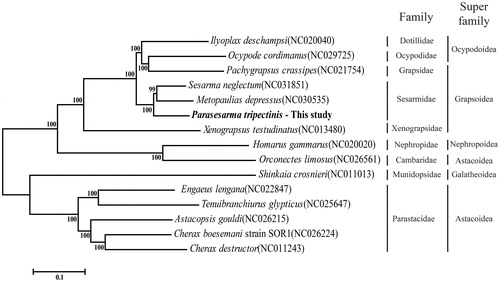Abstract
Parasesarma tripectinis is known as an intertidal crab and inhabits Asian region. This crab has larval release at semilunar rhythm. Here, we report the complete sequence of the mitochondrial genome (mitogenome), which is composed of 15,612 base pair (bp) encoding 13 protein-coding genes, 22 transfer RNAs, 2 ribosomal RNAs, and an A + T rich region. The nucleotide composition of P. tripectinis was G + C: 25.8%, A + T: 74.2%, with a strong AT bias. Phylogenetic analysis using whole mitogenome figured out that P. tripectinis was closely related to Sesarma neglectum which belongs to the same family Sesarmidae.
Parasesarma tripectinis is classified in the family Sesarmidae, and it inhabits intertidal area (Dai et al. Citation1991; Ng et al. Citation2008). This intertidal crab was first discovered in 1940 by a Chinese zoologist, Shen Chia-Jui (Shen Citation1940). This species spreads throughout at intertidal coastal zones in Asia and exhibits semilunar rhythm in reproductive activity by releasing larva (Saigusa Citation1981; Hsueh Citation2002). In general, specific genes such as phosphoenolpyruvate carboxykinase (PEPCK), sodium-potassium ATPase α-subunit (NaK), 16S rRNA (LSU), and cytochrome oxidase subunit I (cox1) are compared for phylogenetic classification of crabs (Schubart et al. Citation2001; Tsang et al. Citation2008). However, it is considered to be more certain to compare whole mitogenomes if possible.
A sample of P. tripectinis was collected in Gangseo-gu, Busan, Republic of Korea (GIS: 35°04’47”N 128°52'36”E). The sample was kept in National Institute of Biological Resources in Korea under the voucher number NIBRGR0000072156. Mitogenomic DNA of P. tripectinis was extracted from muscle tissue sample using QIAamp Tissue Kit (Qiagen, Valencia, CA) (Graham Citation2001). The amplification of mitogenome was performed using a set of mitochondrial specific primers (Martin et al. Citation2016). In PCR cycle, lower extension temperature was used for A + T rich region amplification (Su et al. Citation1996). Next generation sequencing was carried out using the Ion Torrent PGM machine (Life Technologies/Thermo Fisher Scientific, Waltham, MA). Whole mitogenome assembly and annotation were performed using CLC genomics workbench 8.5 (CLC Bio, Denmark). Protein coding genes (PCGs), ribosomal RNA genes (rRNAs), transfer RNA genes (tRNAs) and D-loop were confirmed using NCBI Basic Local Alignment Search Tool (BLAST) (Altschul et al. Citation1990) and tRNA-scan 1.21 (Lowe and Eddy Citation1997), respectively.
The complete mitogenome of P. tripectinis was composed of circular DNA with 15,612 bp containing 13 PCGs, 22 tRNAs, 2 rRNAs and a D-loop. The mitogenome sequence was submitted to GenBank under accession number NC030046. Thirteen PCGs use ATG, ATT or ATA as a start codon. Incomplete stop codons in cox1, cox2, cox3, and cytb were found as T(aa) and TA(a) (Yamauchi et al. Citation2003; Hou et al. Citation2007; Zhang et al. Citation2016). The nucleotide composition was asymmetric (A: 36.2%, T: 38.0%, G: 10.1%, C: 15.7%) with a strong AT bias. Phylogenetic analysis was done with 15 mitogenomes in Decapoda order. Maximum likelihood phylogenetic tree was obtained using MEGA 6.0 (Tamura et al. Citation2013) with bootstrap methods (1000 replicates). The resultant phylogenetic tree indicated that P. tripectinis was mostly closed with Sesarma neglectum (NC031851) which is located in same family and super family (). Based on these results, mitogenome of P. tripectinis could contribute to the phylogenetic knowledge of the family Sesarmidae.
Figure 1. Phylogenetic tree based on 15 whole mitogenomes constructed using maximum likelihood approach. The number in phylogenetic tree is bootstrap probability value. On right side, vertical stick indicated specific family and super family of crab in Decapoda order. The GenBank accession numbers are indicated after the scientific name.

Disclosure statement
No potential conflict of interest was reported by the authors.
Additional information
Funding
References
- Altschul SF, Gish W, Miller W, Myers EW, Lipman DJ. 1990. Basic local alignment search tool. J Mol Biol. 215:403–410.
- Dai A, Yang SL, Song Y, Chen G. 1991. Crabs of the China seas. Beijing, China Ocean Press.
- Graham JM. 2001. Isolation of mitochondria from tissues and cells by differential centrifugation. Curr Protoc Cell Biol. 3.3.1–3.3.15.
- Hou W, Chen Y, Wu X, Hu J, Peng Z, Yang J, Tang Z, Zhou C-Q, Li Y-m, Yang S. 2007. A complete mitochondrial genome sequence of Asian black bear Sichuan subspecies (Ursus thibetanus mupinensis). Int J Biol Sci. 3:85–90.
- Hsueh P-W. 2002. Larval release rhythms of four species (Family Grapsidae and Ocypodidae) of intertidal crabs on a coastal flat in western central Taiwan. J Nat History. 36:1341–1349.
- Lowe TM, Eddy SR. 1997. tRNAscan-SE: a program for improved detection of transfer RNA genes in genomic sequence. Nucleic Acids Res. 25:0955–0964.
- Martin JW, Crandall KA, Felder DL. 2016. Decapod crustacean phylogenetics. New York (NY). CRC Press.
- Ng PK, Guinot D, Davie PJ. 2008. Systema Brachyurorum: Part I. An annotated checklist of extant brachyuran crabs of the world. Raffles Bull Zool. 17:1–286.
- Saigusa M. 1981. Adaptive significance of a semilunar rhythm in the terrestrial crab Sesarma. Biol Bull. 160:311–321.
- Schubart CD, Cuesta JA, Rodríguez A. 2001. Molecular phylogeny of the crab genus Brachynotus (Brachyura: Varunidae) based on the 16S rRNA gene. Adv Decapod Crustacean Res. 449:41–46.
- Shen C-J. 1940. Four new species of Brachyura from Chinese seas. J Hong Kong Fish Res Station. 1:255–262.
- Su X-z, Wu Y, Sifri CD, Wellems TE. 1996. Reduced extension temperatures required for PCR amplification of extremely A + T-rich DNA. Nucleic Acids Res. 24:1574–1575.
- Tamura K, Stecher G, Peterson D, Filipski A, Kumar S. 2013. MEGA6: molecular evolutionary genetics analysis version 6.0. Mol Biol Evol. 30:2725–2729.
- Tsang L, Ma K, Ahyong S, Chan T-Y, Chu K. 2008. Phylogeny of Decapoda using two nuclear protein-coding genes: origin and evolution of the Reptantia. Mol Phylogenet Evol. 48:359–368.
- Yamauchi MM, Miya MU, Nishida M. 2003. Complete mitochondrial DNA sequence of the swimming crab, Portunus trituberculatus (Crustacea: Decapoda: Brachyura). Gene. 311:129–135.
- Zhang Q-X, Guan D-L, Niu Y, Sang L-Q, Zhang X-X, Xu S-Q. 2016. Characterization of the complete mitochondrial genome of the Asian planthopper Ricania speculum (Hemiptera: Fulgoroidea: Ricannidae). Conserv Genet Resources. 8:463–466.
